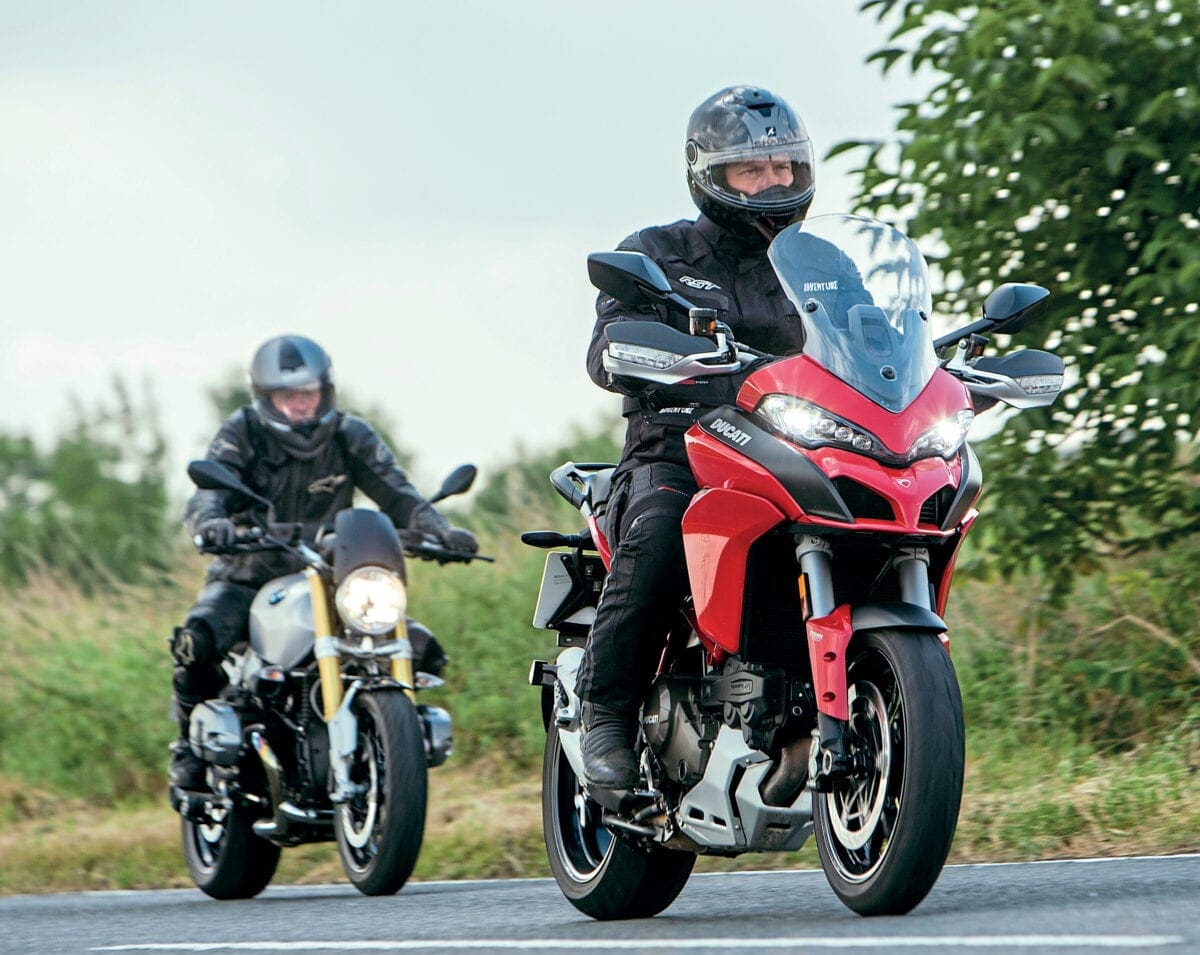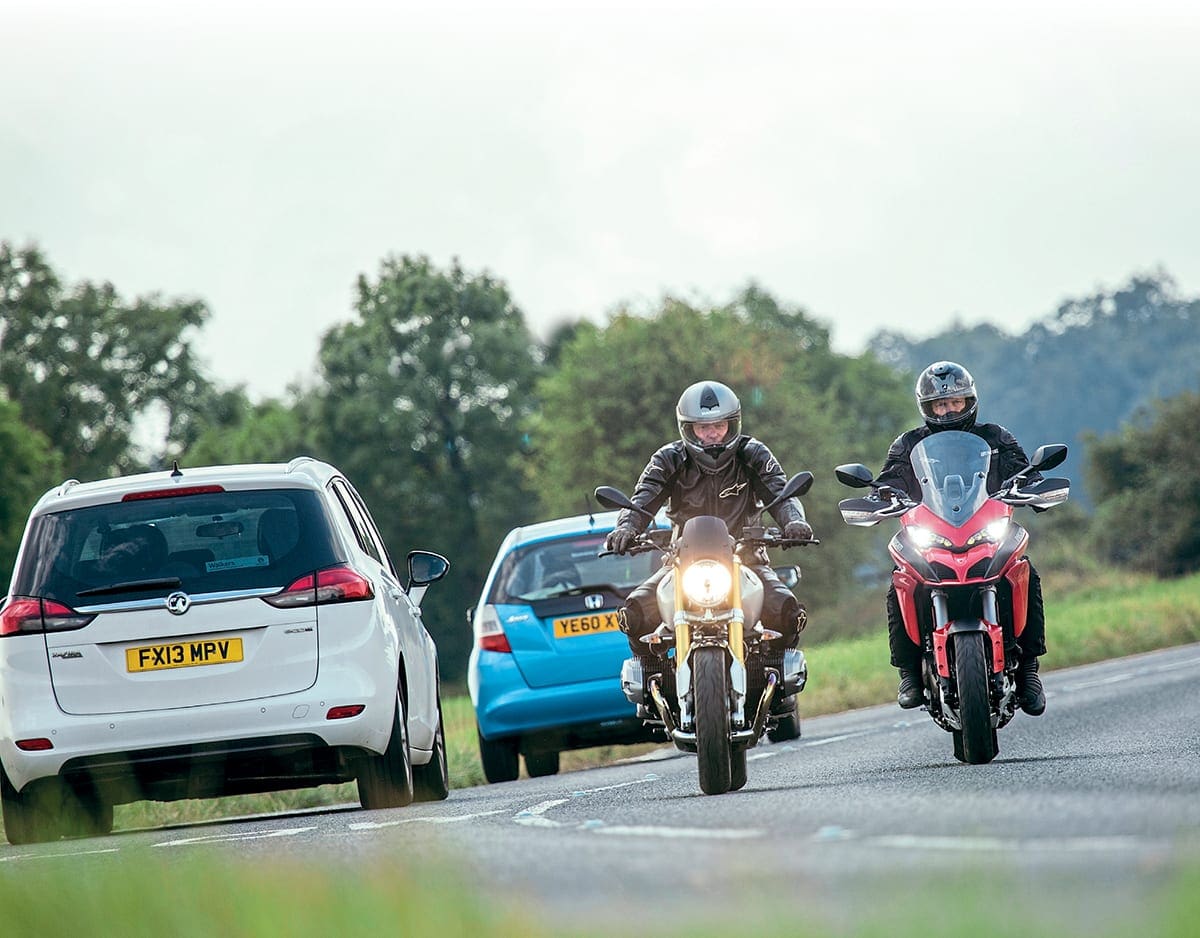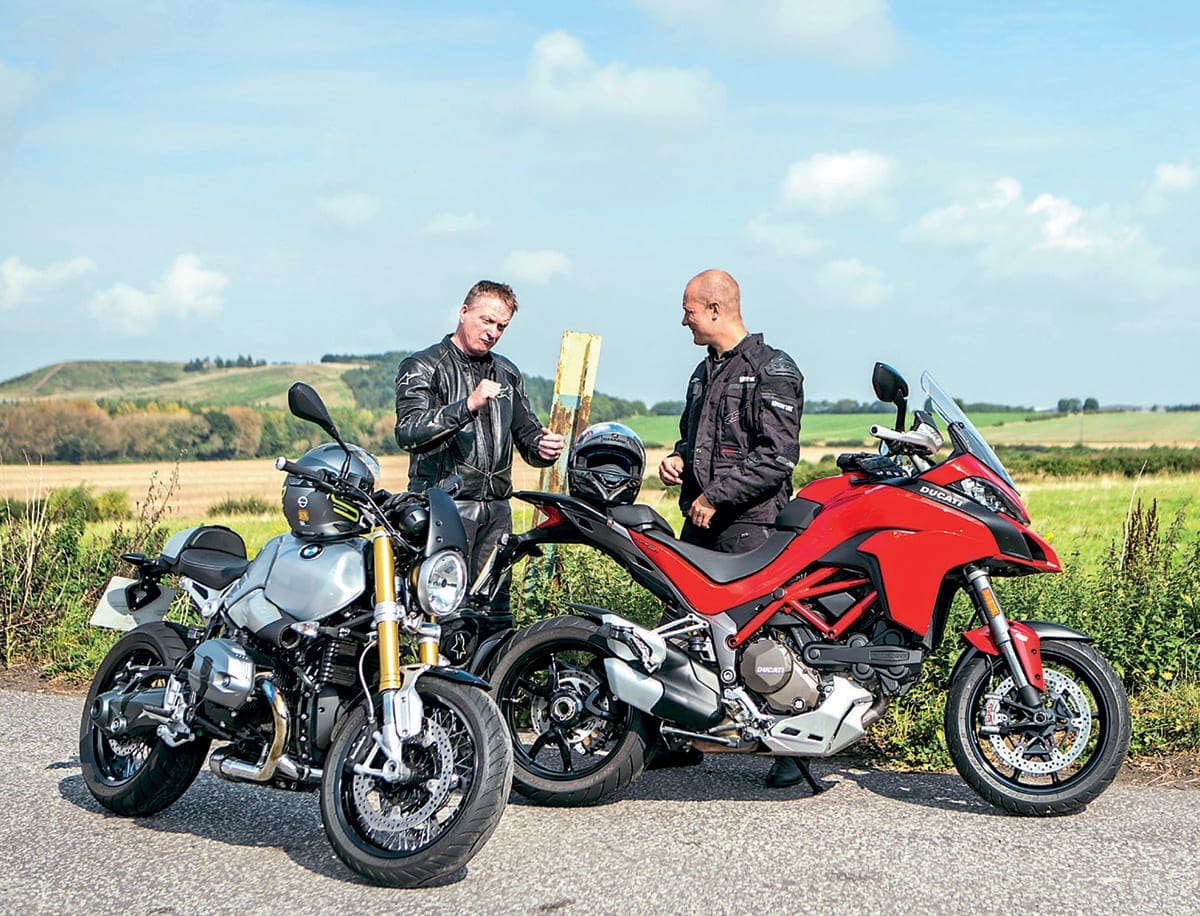The Masters programme from IAM RoadSmart is the highest level civilian road riding qualification in the UK. We signed up to find out just how tough it is to join the Masters club…
There’s an immense sense of satisfaction in pinning an IAM RoadSmart Masters badge to your riding jacket. Mostly because obtaining one is no ride in the park. There are currently only 765 people in the UK who have achieved the IAM RoadSmart Masters qualification, with 436 of those achieving distinction. So breaking into the ranks of these riders isn’t easy, but the ultimate reward – becoming a better rider – was enough to lure me in.
I had achieved my IAM advanced riders’ Green Badge with the Sheffield Advanced Motorists a couple of years ago, and at the time found it a huge help in improving my riding, but in the years that followed the test, I felt I had let the old bad habits creep back into my riding. It was time to refresh my skills and knowledge, and while I was at it I might as well take on a fresh challenge – the Masters programme.
Enjoy everything MSL by reading the monthly magazine, Subscribe here.
WHAT’S IT ALL ABOUT?
It was certainly going to be a challenge: the Masters programme prepares the rider for what IAM RoadSmart calls the highest UK civilian riding standard. You can simply go straight to the test if you’re confident enough in your riding abilities, your knowledge of the Highway Code and the ‘system’ of roadcraft. I, however, opted to go through the ‘mentoring’ route, where for £249 you are assigned a mentor who is a Masters-level rider and an experienced trainer.The number of rides you go on with your mentor is not set in stone, but with the assumption that you’re already an advanced-level rider, the average is around six rides before the test.
Both the aims of the programme (gaining the skills to pass the riding test) and what the training entailed (several observed rides and a fair amount of reading the Motorcycle Roadcraft book) sounded right up my street. This would be fun.
STEADY START
My first ride started well. I met my mentor, Andy Peel from the Rotherham IAM Road Smart group, at the Grindleford railway station café near Sheffield, got briefed about the programme, and off we went, riding on some of the finest roads in Derbyshire and South Yorkshire.
It was raining steadily all day, so after about an hour, we took shelter in a coffee shop for a debrief. Andy was happy with the level of my riding so far. “That was really good, we just need to polish a few areas of your riding and you’ll be well on your way.” But there were, of course, various things to improve; his first bit of advice to me was to extend my views further ahead to make sure I saw and reacted to things earlier to put myself in the right place at the right time. This was followed by what I already knew was my Achilles heel: overtakes. “We can work on building your confidence on overtakes and make sure you get in the right position as soon as the opportunity arises. That’s half the job done.”
That sounded good to me. I just knew I was going to learn loads with this guy.

BUILDING IT UP
The second ride went better than the first, and the third ride improved things further. I felt like I was starting to ‘get’ what the advanced riding, as prescribed by the Masters programme, was getting at.
Being assessed on the rides takes some getting used to. It’s quite unnerving to be followed by a rider who you know is among the best in the country, and constantly assessing your every move. Andy was very encouraging though, and gave good feedback through the radio. He spotted my good moves as well as the poor ones.
The real eye-opener was the demonstration rides that Andy did where he would take the lead and ride while giving a running commentary of what he saw and how he altered his riding plan accordingly.
To say that I was gobsmacked by the sheer volume of information that Andy was taking in and using to plan his ride would be an understatement. From road markings and traffic signs to people’s movements on the pavement, Andy was processing much more information than I had ever thought possible, and he was spotting everything much earlier than I was.
“Sorry, it’s all a bit late and rushed, the mouth can’t keep up with the brain,” he apologised over the radio. Blimey! How much more was he actually seeing? I knew this was always going to be a steep learning curve, but if I hadn’t got the message yet, it was blatantly obvious now: I had to up my game further, and I needed to do it fast!
FEELING LUCKY?
It took a few rides to settle into the new way of riding. I still needed to work on my positioning, overtakes and especially on extending my vision further ahead to spot any developing dangers and opportunities earlier, but I felt like I had improved. I was now at a point in my development where I knew what the expectations of my riding were; now it was just a case of consistently delivering a ride that demonstrated this understanding.
It was easier said than done though. There are so many little things that are easy to miss, especially when riding in busy environments: someone getting ready to press the button at a pedestrian crossing, a reflection in a shop window of a car emerging from a side street, a cyclist just about to change direction and potholes to negotiate all demand attention. Prioritising the hazards quickly, and then effectively using the information to amend your riding plan is not the easiest thing to do, but it’s not impossible. After a few sessions Andy was happy that I had reached test level.That was it then – time book my test!

IF AT FIRST YOUDON’T SUCCEED…
My test was booked for a December morning to be taken in and around Doncaster. It all started well. The examiner and I had a quick chat about the Masters programme – something of a dark art, according to him – and where our route would take us, then set off. The route was pleasant, with some winding country lanes dotted with little villages, a couple of railway crossings, a range of different traffic situations to deal with, and finally finishing the ride in central Doncaster.
I thought I had done okay – enough to scrape through. It was only right at the end of the ride that I realised that something wasn’t right. Riding in front of me to guide us to a café for a debrief, the examiner’s head seemed to be in constant motion, with exaggerated mirror and shoulder checks in rapid succession as we progressed through town. I couldn’t help feeling that he was proving a point with this.
As we got off our bikes, my suspicions were confirmed: “I’m afraid that your ride didn’t come up the standard,” was the initial feedback, “Let’s go in for a coffee, there’s a lot to talk about.”That didn’t sound promising.
The first criticism was stopping. Apparently, you should always finish braking on the rear brake and put your left foot on the ground as you come to a standstill. I had been using the front brake so that I could put my right foot down and instantly select neutral if I needed to – which is not the way to do it, as it turned out.
The second issue was my lane positioning: I had changed my position too much, trying to keep my imaginary ‘safety bubble’ around me as big as possible. This included moving too much to a nearside position for oncoming vehicles. The examiner wanted me to maintain my position roughly 60% away from the nearside, and only move for lorries or slow moving vehicles because there might be someone behind them looking to overtake.
There were also issues with me not using my indicators in situations where there were no other road users in sight (they could have emerged) and my shoulder checks (they need to be done for every change of position).
I could now understand what the examiner had meant by the Masters being a dark art – it was back to the drawing board for Andy and I. Good job we both like a challenge!
RECALIBRATING
After the failed test, Andy and I set about honing my ride to the point where there could be no surprises when it came to retaking the test. We’d both been a bit perplexed by the examiner’s feedback, but the programme is still fairly young and the standards are still being levelled between mentors and examiners in different corners of the country. The only thing we could do was further improve my riding.
Concentrating on rear observations, positioning, the correct way of stopping and still improving my planning and general roadcraft we went on for a few more rides.
At the time, I had been a bit peeved with the examiner’s comments, thinking that he had just picked on details rather than the bigger picture, but taking his comments on board actually helped me to further improve my riding. I could feel it becoming more accurate and crisp, to the degree that I felt sure I was ready for another test.
FINAL BREAKTHROUGH
The retest was in the same location but on different roads, and with a different examiner. “Now, the key thing is that we’re going to have some fun today,” were pretty much his first words. I was already liking this chap a lot more. The brief was still the same: I was to ride in front and produce a Masters-level ride. This time I felt a lot more comfortable about the whole thing. Partly because of all the extra prep I’d done with Andy, partly because of the easy manner of the examiner, and I suppose partly because I thought “Damn it, I’m just going to ride like I normally ride and see what happens.”
Again, the route combined some lovely country lanes, town and dual carriageways, so we got a good mix of roads. I could feel the ride flowing, but didn’t want to get ahead of myself and kept reminding myself to concentrate on the task at hand.
At the end of the ride we pulled up at a well-known American burger restaurant for a coffee and a debrief. I was on tenterhooks waiting for the judgment, but the examiner soon put me at ease: “That was a great ride – I really enjoyed myself! It’s a pass with distinction, no doubt about it.”
Phew, that was a relief. I don’t think my blood pressure could have taken another test.

WAS IT WORTH IT?
With two house moves and the birth of my son somewhat dominating my schedule, it took me the best part of a year to get through the Masters programme. At times it was frustrating and challenging when you felt like you weren’t making enough progress (with the programme or on the roads), but with everything coming together in the end the overall experience was thoroughly enjoyable. After all, if it wasn’t a decent challenge what would be the point?
Despite clocking up a lot of miles each year for work and pleasure, my riding was in need of some refining, and setting the bar high helped to get me motivated for the task. If you’re an advanced-level rider and a member of the IAM, I would recommend talking to one of the Masters mentors about the course to see if it suits you. If you’re not an IAM member but would like to improve your riding, the best thing to do is to contact a local group to get started. I guess what you think about the Masters programme will be highly personal, and views will vary, but for me it was an incredibly useful tool for improving my riding.
IAM RoadSmart is a road safety charity, aiming to make better drivers and riders through coaching and education. With over 200 local groups and an army of thousands of volunteers, IAM RoadSmart is one of the best-known brands in advanced riding in the UK. At any one time there are more than 7000 drivers and riders engaged in IAM RoadSmart courses. ■ Info: www.iamroadsmart.com






